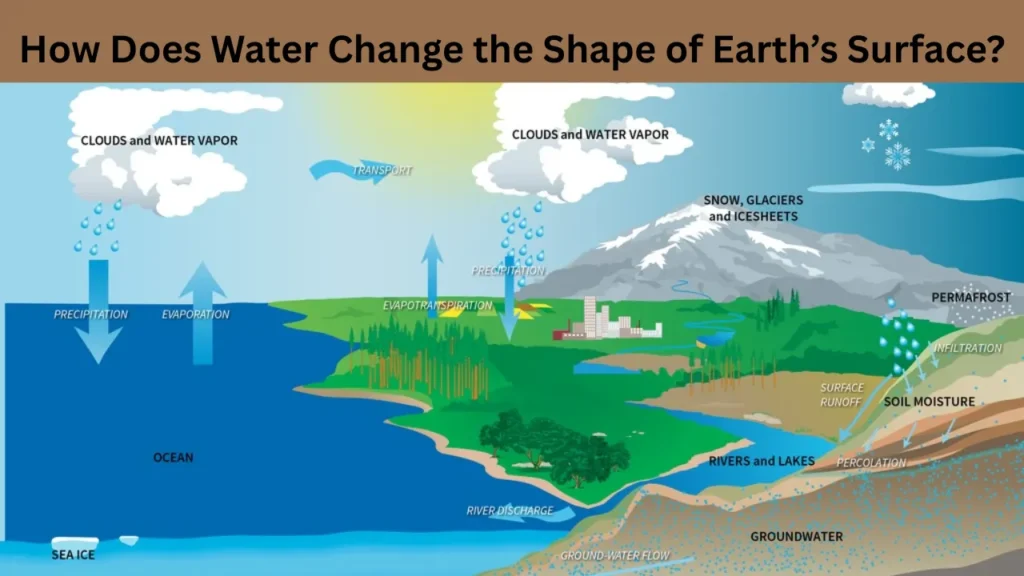Water is one of the most powerful natural forces on Earth. It doesn’t just sustain life — it also transforms the land around us every single day. How does water change the shape of Earth’s surface? The answer lies in natural processes like erosion, transportation, and deposition. These processes take place in rivers, oceans, rainstorms, glaciers, and underground water flows. Over time, they create valleys, canyons, cliffs, beaches, and more. Let’s explore how water helps mold and reshape our planet.
Read more: cenpok.com
Erosion: Nature’s Sandpaper
One of the most important ways how water changes the shape of Earth’s surface is through erosion. Erosion happens when moving water wears down soil, rocks, and even entire mountains. Rainwater falling on bare soil can cause the land to wash away. Rivers erode the banks and beds they flow through. Waves crashing against coastlines gradually wear them down.
A great example of erosion is the Grand Canyon in the United States. The Colorado River carved it over millions of years. The river’s flowing water cut deep into the rock, creating one of the most famous natural wonders on Earth.
Erosion doesn’t happen quickly. It takes hundreds or even thousands of years. Still, the impact is huge. Erosion changes landscapes, flattens hills, and breaks down mountains.
Read more: Doctorhub360.com Neurological Diseases: Symptoms, Treatment
Transportation: Moving Earth’s Building Blocks
Once erosion occurs, water picks up and carries away the sediments — bits of soil, sand, and rock. This process is called transportation. How does water change the shape of Earth’s surface? Part of the answer lies in this constant movement of materials.
Streams and rivers carry sediments for miles. The faster the water moves, the more it can carry. When water slows down, heavier particles settle to the bottom first. Lighter particles like silt and clay travel farther before they drop.
Let’s look at a mountain stream. When the stream flows downhill, it collects pebbles and soil. These materials travel down the river. Over time, they shape the land they pass through, smoothing rocks and forming riverbanks.
Read more: lab-banana.com Business: A Unique Digital Content Platform
Deposition: Building New Land
Eventually, water loses energy and drops the materials it carries. This process is called deposition. It often happens where a river slows down — like where it meets a lake or ocean. The dropped materials build up over time, forming new land.
How does water change the shape of Earth’s surface? Deposition helps create features like deltas, sandbars, and floodplains. One famous example is the Nile Delta in Egypt. The Nile River flows into the Mediterranean Sea and leaves behind layers of rich soil. This soil makes the land around the delta perfect for farming.
Floodplains are another result of deposition. When rivers flood, they spread out and drop silt across nearby land. This makes the soil very fertile and great for growing crops.
Read more: How Pet Brands Are Using Boutique Packaging to Win Over Millennial Buyers
Table: How Water Shapes the Land
| Process | What Happens | Examples |
|---|---|---|
| Erosion | Water wears away rock and soil | Grand Canyon, cliffs, gorges |
| Transportation | Water moves particles from one place to another | Riverbeds, sand carried downstream |
| Deposition | Water drops particles to form new land | Deltas, floodplains, beaches |
How Does Water Change the Shape of Earth’s Surface in Oceans?
Oceans are powerful forces that constantly reshape coastlines. Waves crash against cliffs and beaches, slowly wearing them down. At the same time, water may deposit sand and pebbles elsewhere, forming new beaches, sandbars, or barrier islands.
Tides and currents also move sediments along the shore. Storm surges during hurricanes can rapidly change coastal landforms. Entire beaches can disappear, and new land can form in just a few days.
How does water change the shape of Earth’s surface? Oceans show us that water doesn’t need a long time to make big changes. One strong storm can do more than years of steady waves.
Read more: Apple Sign AppleMiller9to5Mac: Secure Login Meets Trusted News
Groundwater and Caves
Water doesn’t just change the land we can see — it also shapes the land below our feet. Groundwater is water stored underground in soil and rock. Over time, it dissolves certain kinds of rock, especially limestone. This creates caves and sinkholes.
Caves often form when acidic groundwater slowly wears away rock layers. The space left behind becomes a cave. When the roof of a cave collapses, a sinkhole forms at the surface. These features are common in places like Florida, Kentucky, and parts of China.
How does water change the shape of Earth’s surface? Even underground, water quietly sculpts the land, changing its shape from below.
Glaciers: Frozen Rivers That Shape the Land
Glaciers are another form of water that transforms Earth’s surface. Though they’re frozen, they still move slowly over time. As they slide over the ground, glaciers pick up rocks and soil, grinding away at the land beneath.
This process creates U-shaped valleys, fjords, and moraines. In places like Alaska and Norway, glaciers carved massive valleys that are now filled with seawater.
When glaciers melt, they deposit the materials they carried. This forms landforms like drumlins and eskers — ridges made of gravel and sand.
Human Activities and Water’s Effects
People also change how water shapes the land. Cities, roads, and farms affect how water flows and where it goes. For example, when trees are removed, soil becomes loose and easier to wash away. This increases erosion.
Building dams and levees can control water flow but may also cause sediment to build up in places it normally wouldn’t. Pollution and climate change affect water’s movement, too.
How does water change the shape of Earth’s surface? Today, the answer includes both natural and human-made influences. Understanding this helps us make better choices to protect the land.
Real-World Examples Around the Globe
The effects of water on land are easy to see when we look around the world. Let’s explore a few locations where water has had a major impact:
| Location | How Water Changed the Land |
|---|---|
| Grand Canyon, USA | River erosion created deep canyons over millions of years |
| Nile Delta, Egypt | River deposition formed a wide, fertile farming area |
| Amazon Basin, South America | Flooding and sediment created vast floodplains |
| Norway Fjords | Glaciers carved out deep valleys filled by sea water |
| Florida, USA | Groundwater erosion created caves and sinkholes |
Why This Matters Today
Understanding how does water change the shape of Earth’s surface helps us prepare for natural events. Floods, landslides, and erosion can all cause damage. When we know how water shapes land, we can plan smarter cities, protect the environment, and reduce disaster risks.
For example, farmers use terraces to slow erosion on hills. Engineers build levees to control river flooding. Scientists study glaciers to understand sea-level rise.
Water will always shape Earth — that’s a fact we cannot change. But we can adapt and work with nature instead of against it.
Conclusion
So, how does water change the shape of Earth’s surface? Through the endless work of erosion, transportation, and deposition, water sculpts valleys, carves canyons, and builds new land. It shapes coastlines, digs caves, and forms deltas.
Glaciers grind down mountains. Rivers carry soil across continents. Rain and groundwater change the land both above and below the surface.
Water is always in motion, and the changes it brings are everywhere. By studying these changes, we better understand the natural world. We also learn how to live with the forces that shape our home planet.



